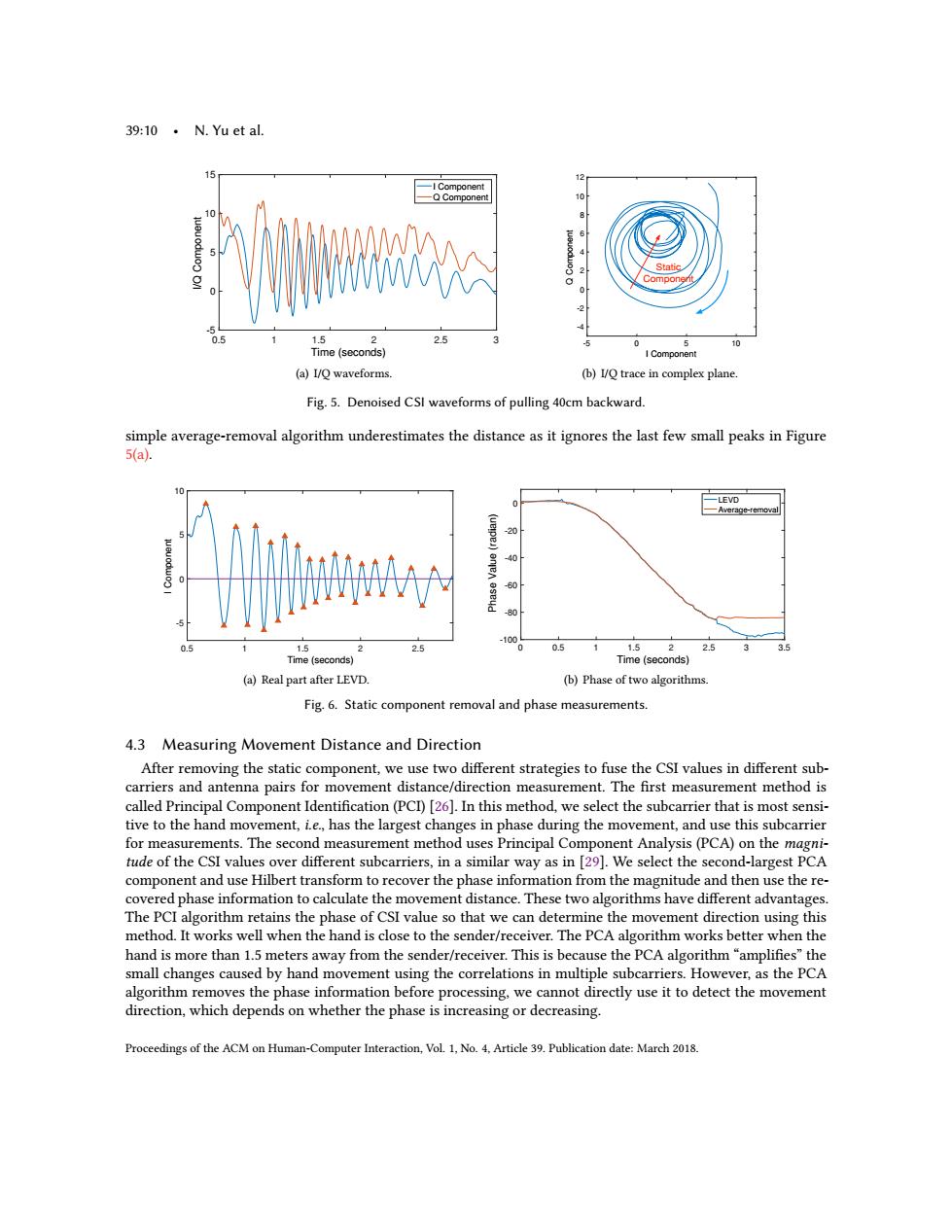正在加载图片...

39:10·N.Yu et al. 15 -I Component QComponen 0 10 2 Static g 0 0.5 1.5 2 2.5 0 5 10 Time(seconds) I Component (a)I/O waveforms. (b)1/O trace in complex plane. Fig.5.Denoised CSl waveforms of pulling 40cm backward. simple average-removal algorithm underestimates the distance as it ignores the last few small peaks in Figure 5(a). -LEVD -Average-remov 20 -40 -60 80 -10 1 2.5 0 0.5 1 1写2 2.5 3 3.5 Time(seconds) Time(seconds) (a)Real part after LEVD. (b)Phase of two algorithms Fig.6.Static component removal and phase measurements 4.3 Measuring Movement Distance and Direction After removing the static component,we use two different strategies to fuse the CSI values in different sub- carriers and antenna pairs for movement distance/direction measurement.The first measurement method is called Principal Component Identification(PCD)[26].In this method,we select the subcarrier that is most sensi- tive to the hand movement,i.e.,has the largest changes in phase during the movement,and use this subcarrier for measurements.The second measurement method uses Principal Component Analysis(PCA)on the magni- tude of the CSI values over different subcarriers,in a similar way as in [29].We select the second-largest PCA component and use Hilbert transform to recover the phase information from the magnitude and then use the re- covered phase information to calculate the movement distance.These two algorithms have different advantages. The PCI algorithm retains the phase of CSI value so that we can determine the movement direction using this method.It works well when the hand is close to the sender/receiver.The PCA algorithm works better when the hand is more than 1.5 meters away from the sender/receiver.This is because the PCA algorithm"amplifies"the small changes caused by hand movement using the correlations in multiple subcarriers.However,as the PCA algorithm removes the phase information before processing,we cannot directly use it to detect the movement direction,which depends on whether the phase is increasing or decreasing. Proceedings of the ACM on Human-Computer Interaction,Vol.1,No.4,Article 39.Publication date:March 2018.39:10 • N. Yu et al. 0.5 1 1.5 2 2.5 3 Time (seconds) -5 0 5 10 15 I/Q Component I Component Q Component (a) I/Q waveforms. -5 0 5 10 I Component -4 -2 0 2 4 6 8 10 12 Q Component Static Component (b) I/Q trace in complex plane. Fig. 5. Denoised CSI waveforms of pulling 40cm backward. simple average-removal algorithm underestimates the distance as it ignores the last few small peaks in Figure 5(a). 0.5 1 1.5 2 2.5 Time (seconds) -5 0 5 10 I Component (a) Real part after LEVD. 0 0.5 1 1.5 2 2.5 3 3.5 Time (seconds) -100 -80 -60 -40 -20 0 Phase Value (radian) LEVD Average-removal (b) Phase of two algorithms. Fig. 6. Static component removal and phase measurements. 4.3 Measuring Movement Distance and Direction After removing the static component, we use two different strategies to fuse the CSI values in different subcarriers and antenna pairs for movement distance/direction measurement. The first measurement method is called Principal Component Identification (PCI) [26]. In this method, we select the subcarrier that is most sensitive to the hand movement, i.e., has the largest changes in phase during the movement, and use this subcarrier for measurements. The second measurement method uses Principal Component Analysis (PCA) on the magnitude of the CSI values over different subcarriers, in a similar way as in [29]. We select the second-largest PCA component and use Hilbert transform to recover the phase information from the magnitude and then use the recovered phase information to calculate the movement distance. These two algorithms have different advantages. The PCI algorithm retains the phase of CSI value so that we can determine the movement direction using this method. It works well when the hand is close to the sender/receiver. The PCA algorithm works better when the hand is more than 1.5 meters away from the sender/receiver. This is because the PCA algorithm “amplifies” the small changes caused by hand movement using the correlations in multiple subcarriers. However, as the PCA algorithm removes the phase information before processing, we cannot directly use it to detect the movement direction, which depends on whether the phase is increasing or decreasing. Proceedings of the ACM on Human-Computer Interaction, Vol. 1, No. 4, Article 39. Publication date: March 2018